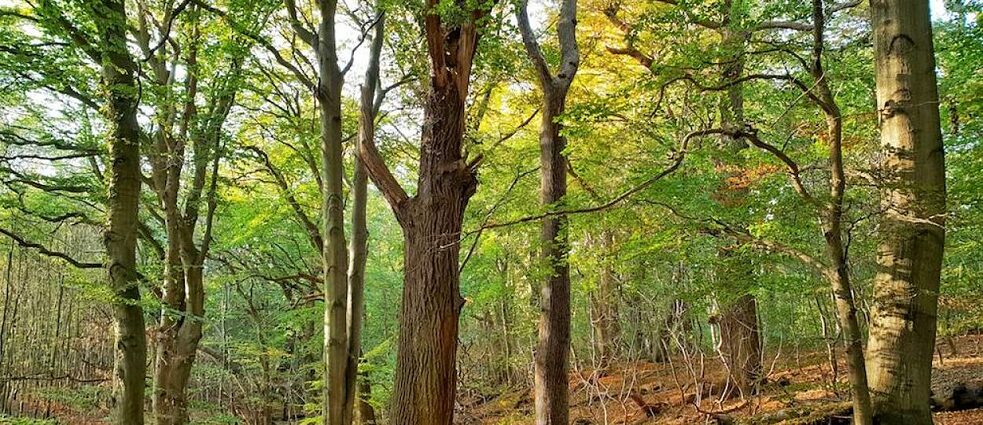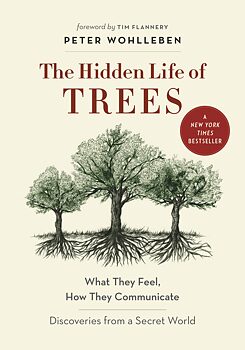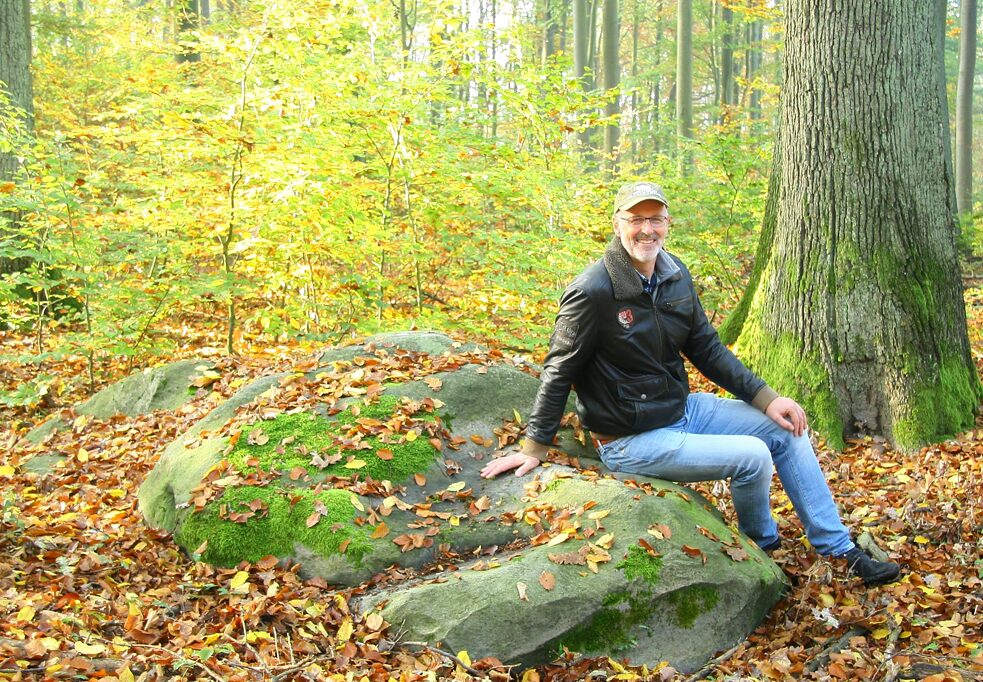Transitions Film Festival
‘The Hidden Life of Trees’ is detailed and meditative

When Peter Wohlleben explored the signals that plants send to each other in his 2015 book The Hidden Life of Trees, it became a bestseller. The documentary of the same name brings the German forester’s observations to the screen in a vivid fashion, while also stepping through his efforts to change the way that the world looks at greenery in the fight against climate change.
By Sarah Ward
 "The Hidden Life of Trees" has sold around 4 million copies worldwide
| © Ludwig Verlag
Whenever a German forest appeared on-screen between 2017 and 2020, it usually came packaged with moody sci-fi thrills, a thumping soundtrack, and the possibility that its foliage could exist at any time between 1888 and 2053. But TV series Dark isn’t the only reason that people the world over have been thinking about European woodlands over the past few years. Thanks to Peter Wohlleben and his 2015 non-fiction book The Hidden Life of Trees, the subject has remained a popular topic for a far more important reason. That isn’t a criticism of Netflix’s excellent television series. Rather, it’s recognition that the forester and author’s ecological message is timely, and that his thoughts on how plants communicate with each other are informative and astute. Also important, as explored in the documentary that’s also called The Hidden Life of Trees: how perceptions about the environment, nature and trees specifically need to adapt and evolve if humanity is going to save itself from destroying the planet.
"The Hidden Life of Trees" has sold around 4 million copies worldwide
| © Ludwig Verlag
Whenever a German forest appeared on-screen between 2017 and 2020, it usually came packaged with moody sci-fi thrills, a thumping soundtrack, and the possibility that its foliage could exist at any time between 1888 and 2053. But TV series Dark isn’t the only reason that people the world over have been thinking about European woodlands over the past few years. Thanks to Peter Wohlleben and his 2015 non-fiction book The Hidden Life of Trees, the subject has remained a popular topic for a far more important reason. That isn’t a criticism of Netflix’s excellent television series. Rather, it’s recognition that the forester and author’s ecological message is timely, and that his thoughts on how plants communicate with each other are informative and astute. Also important, as explored in the documentary that’s also called The Hidden Life of Trees: how perceptions about the environment, nature and trees specifically need to adapt and evolve if humanity is going to save itself from destroying the planet.
Part David Attenborough-style documentary, part activist chronicle, The Hidden Life of Trees weaves together multiple formats of nature-centric filmmaking. Wohlleben’s narration explains how tree roots reach out to each other and, although the movie itself doesn’t make the leap, that’s an apt metaphor for the feature’s blended strategy. The film adopts the observational approach of animal-focused fare, using close shots of trees and plants existing in the wild, charting their development and movement through time-lapse visuals, and speaking through the particulars via voiceover. It also takes the change-in-action perspective that’s become a key component of eco-conscious efforts such as fellow German production NOW, tagging along with Wohlleben and peeking behind the scenes of his daily work. Director Jörg Adolph mightn’t have wanted to choose between the two, but he does leave his viewers wanting more. The entire documentary could’ve peered intimately at trees and it would’ve been riveting. It could’ve detailed Wohlleben’s tours, talks and general efforts, and it would’ve remained fascinating as well.
 Peter Wohlleben's tours of his local forest in Hümmel, Germany, are a major part of the film
| © Piotr Tyszko-Chmielowiec
Peter Wohlleben's tours of his local forest in Hümmel, Germany, are a major part of the film
| © Piotr Tyszko-Chmielowiec
THE DISARMINGLY CALMING MINUTIAE
The Hidden Life of Trees isn’t split into neat halves, preferring to weave its varied styles throughout the film’s numerous chapters. Still, the documentary’s different modes stand out from each other. When Adolph takes a purist approach, he makes a movie — or part of it, at least — that’s not just educative but meditative. In Wohlleben’s discussion, he conveys how trees make people feel, and why we’re drawn to them. That might seem like a difficult sensation to translate to the screen, with the audience unable to touch the bark, feel the leaves, hear the branches swaying in the wind and watch the birds nesting. And yet, with the right cinematography, it proves deceptively easy. Attenborough’s work with animals has routinely achieved the same feat for decades, and 2017 documentary The Ancient Woods did as well, the latter without using any narration. The concept drives the wood-focused, Keanu Reeves-voiced episode of television series A World of Calm, too, which aptly recognises that exceptionally shot nature imagery can be both relaxing and transporting.
Details, facts, figures and tidbits keep flowing as The Hidden Life of Trees looks on, showing branches growing, fungi expanding and greenery interacting socially, and it’s all riveting. Such intricate observation and spectacular footage is also wholly and repeatedly necessary. Wohlleben is an assured and charismatic speaker, but his is a topic that benefits from showing, not just telling. The film’s soothing pockets also help put the many sights of plantation forests, felled land, monoculture woodland and lone trees positioned around urban streets in context, leaving viewers with no doubt as to which is the better option. And, when Wohlleben takes a trip to Sweden to see the world’s oldest tree, Old Tjikko — which dates back nearly 10,000 years, sits alone on a mountain and has attained a complex series of shrub-like roots to support the spruce’s trunk — it’s all the more potent after paying such diligent attention to trees that aren’t likely to reach such an immense age.
THE CALL TO ACTION
Adolph and Wohlleben's combined aim isn’t wellness, peacefulness or pacification though. In fact, The Hidden Life of Trees strives for the opposite. Immersive imagery is one of its two key tactics, with honing in on Wohlleben the second. It’s here that the film finds time for biographical details, its subject’s journey to this point, the reason for his passion and the success of his book. The documentary advocates his perspectives, too, connecting the dots between his insights into the lives of trees and the forest’s essential role in protecting the planet. Accordingly, the movie becomes a portrait, a tribute to Wohlleben’s quest to change forestry management techniques and a snapshot of his business, Wohllebens Waldakademie, that endeavours to spread the word.
It’s here that The Hidden Life of Trees proves both dense and urgent as well, and layered. Science features heavily when the camera gazes at trees rather than Wohlleben’s face, but those details spring back to mind when the film switches from staring deeply at the vital living organisms that its central figure so devotedly cherishes. Adolph doesn’t always find the right balance between the feature’s two modes, or segue from one to the other seamlessly, but his documentary still has the desired effect. It sees the forest as a thriving community, and one of the earth’s basic building blocks. It also sees the trees and their interconnected bonds to each other, and to life in general. And, it conveys the crucial part that each lone shrub and crowded thicket plays in maintaining an ecosystem that humanity can call home.
The documentary The Hidden Life of Trees screens in Australia for the first time from February 26th, 2021 at the Transitions Film Festival.